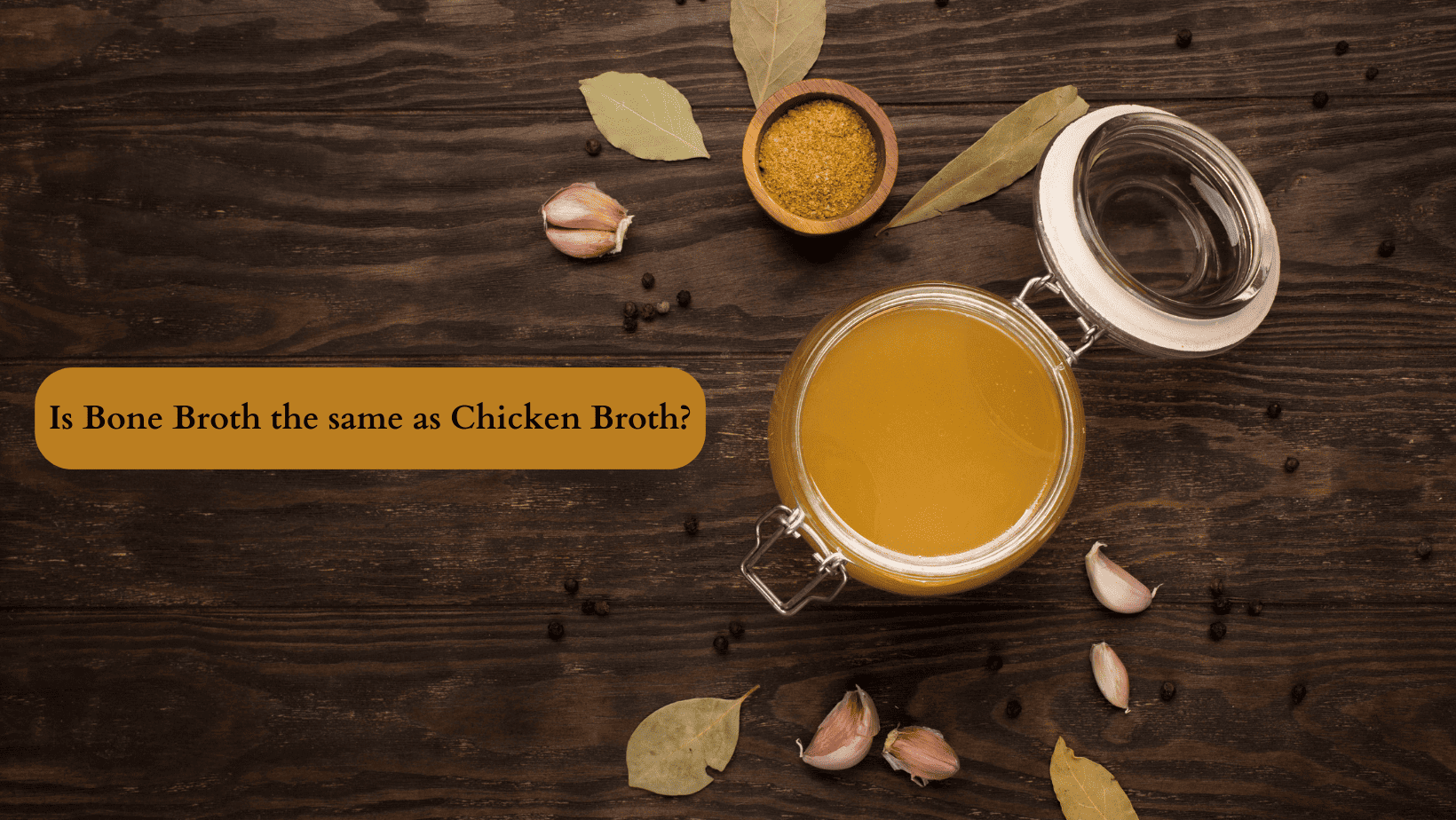Is Bone Broth the Same as Chicken Broth?
Broth has been a staple in kitchens across the world for centuries. From nourishing soups to delicious stews, broth has always been a key ingredient in many dishes. Two popular types of broth are bone broth and chicken broth. They may seem similar, but they are quite different. So if you are wondering, “is bone broth the same as chicken broth?”, then you will want to continue to find out!
Understanding Broth Basics
Broth is a flavorful liquid that is commonly used as a base for soups, stews, and sauces. It is made by simmering bones, meat, vegetables, and herbs in water for an extended period. The resulting liquid is rich in nutrients and flavor, making it a popular ingredient in many dishes.
So, is Bone Broth the same as Chicken Broth?
Simply? Yes and no. Yes, they are the same in terms of the fact they are broths made from bone. However, in terms of nutritional value, bone and chicken broth can greatly differ.
Key Differences Between Bone Broth and Chicken Broth
Broths are a staple in many kitchens, and they are used in a variety of recipes. Bone broth and chicken broth are two popular types of broths that are often used interchangeably, but they have some significant differences.
Ingredients and Preparation
As mentioned earlier, the primary difference between bone broth and chicken broth lies in their ingredients. Bone broth is made using bones, while chicken broth is made using meat and bones. The bones used in bone broth can be from any animal; however, the most common is beef. The bones are usually roasted before being simmered in water for an extended period, usually 24 hours or more, allowing the bones to release collagen and gelatin, giving broth its unique texture.
Chicken broth is made the same way; however, the meat is generally still included, and the cooking process doesn’t typically take as long. While bone broth is generally hailed for its nutritional value, of which chicken does have, chicken broth is generally thought more of a base for soups or an additive to tasty recipes.
Nutritional Content
Bone broth is known for its rich nutritional content, which is not found in chicken broth. The extended cooking time allows the bones to release essential nutrients such as collagen, gelatin, glucosamine, and chondroitin sulfate. These nutrients are essential for healthy joints, skin, and hair. Bone broth is also rich in minerals such as calcium, magnesium, and phosphorus.
Chicken broth, on the other hand, is low in minerals and nutrients compared to bone broth. However, it is still a good source of protein and can be a healthy addition to your diet.
Health Benefits of Bone Broth and Chicken Broth
Benefits of Bone Broth
Bone broth has been a staple in many cultures for centuries and for good reason. Not only is it delicious, but it’s also incredibly nutritious. Bone broth is made by simmering animal bones and connective tissue for an extended period, which extracts all beneficial nutrients and minerals.
One of the main benefits of bone broth is its ability to support healthy joints. The collagen and gelatin found in bone broth are essential building blocks for healthy cartilage, which can help reduce joint pain and stiffness. Additionally, bone broth is rich in minerals like calcium, magnesium, and phosphorus, which are important for maintaining strong bones.
But the benefits of bone broth don’t stop there. The amino acids found in bone broth, such as glycine and proline, have been shown to improve gut health by reducing inflammation and repairing the intestinal lining. This can help alleviate symptoms of digestive issues like leaky gut syndrome and irritable bowel syndrome (IBS).
Bone broth is also great for boosting the immune system. The high concentration of nutrients and minerals in bone broth can help support the body’s natural defenses and fight off infections and illnesses.
Benefits of Chicken Broth
Like bone broth, chicken broth is also incredibly nutritious and has numerous health benefits. Chicken broth is made by simmering chicken bones, vegetables, and herbs in water for several hours, which extracts all of the beneficial nutrients.
One of the main benefits of chicken broth is its ability to boost the immune system. Chicken broth contains a high concentration of the amino acid cysteine, which has been shown to thin mucus in the lungs and make it easier to breathe. This can be especially helpful for those with respiratory infections like colds and flu.
Chicken broth is also a great source of protein, which is essential for muscle growth and repair. Protein is made up of amino acids, which are the building blocks for muscle tissue. Drinking chicken broth can help support muscle recovery after a workout or injury.
One of the most overlooked benefits of chicken broth is its ability to hydrate the body. Chicken broth is mostly made of water, making it a great way to replenish fluids and electrolytes lost through sweat or illness.
So whether you prefer bone broth or chicken broth, both are incredibly nutritious and offer a wide range of health benefits. Incorporating broth into your diet is a simple and delicious way to support your overall health and well-being.
Common Uses in Cooking
Bone broth and chicken broth are versatile ingredients that can be used in various dishes. Here are some more details on when to use each one:
When to Use Bone Broth
Bone broth is a nutrient-dense ingredient that is perfect for slow-cooking dishes. Its rich flavor and texture make it ideal for stews, soups, and casseroles. When you use bone broth in these types of dishes, it provides a depth of flavor that can’t be achieved with regular broth or stock.
In addition to being a great base for slow-cooked dishes, bone broth is also a fantastic ingredient to use in sauces and gravies. Its natural gelatin content gives these sauces a silky texture and a rich, savory flavor.
But bone broth isn’t just great for cooking. It’s also a nutritious and healing beverage that can be enjoyed on its own. Many people drink bone broth as a way to support their immune system, improve gut health, and reduce inflammation in the body.
When to Use Chicken Broth
Chicken broth is a lighter and more delicate ingredient than bone broth. Its mild flavor and thinner consistency make it ideal for quick-cooking dishes where you want to keep the flavors light and fresh.
One of the most common uses for chicken broth is in stir-fries. Because stir-fries are cooked quickly over high heat, you want a broth that won’t overpower the other ingredients. Chicken broth provides just the right amount of flavor and moisture to keep your stir-fry juicy and delicious.
Chicken broth is also a great ingredient to use in risotto. The broth adds a subtle flavor that complements the creamy rice and the other ingredients in the dish. And because risottos are cooked slowly, the broth has time to infuse the dish with its delicious flavor.
Finally, chicken broth is a key ingredient in many sauces and gravies. Its mild flavor allows the other ingredients to shine, while its thin consistency makes mixing with other liquids and thickeners easy.
Whether you’re using bone broth or chicken broth, these versatile ingredients are sure to add flavor and nutrition to your favorite dishes.
Making Your Own Bone Broth and Chicken Broth
Bone broth and chicken broth are incredibly nutritious and versatile ingredients that can be used in various recipes. Making your own broth at home is not only easy but also allows you to control the quality of the ingredients and customize the flavor to your liking.
Bone Broth Recipe
This bone broth recipe is perfect for anyone looking to add more collagen and minerals to their diet. It’s also a great way to use up leftover bones from a roast or a whole chicken.
- Start by gathering your ingredients. You’ll need 1 pound of beef or chicken bones, one onion, two carrots, two celery stalks, 3 cloves of garlic, one tablespoon of apple cider vinegar, 8 cups of water, and salt and pepper to taste.
- Place the bones, vegetables, garlic, and apple cider vinegar in a large pot. Cover with water.
- Bring the mixture to a boil, then reduce the heat and let it simmer, covered, for 24 to 48 hours. The longer you let it simmer, the more nutrients and flavor will be extracted from the bones.
- Once the broth is done simmering, add salt and pepper to taste.
- Using a fine mesh strainer, strain out the bones and vegetables from the broth.
- Your bone broth is now ready to use! You can use it immediately or store it in the fridge or freezer for later use.
Bone broth is delicious on its own and can also be used as a base for soups, stews, and sauces. It’s a great way to add depth of flavor to any dish.
Chicken Broth Recipe
Chicken broth is a classic ingredient that can be used in a variety of recipes, from chicken noodle soup to risotto.
- To make chicken broth, you’ll need 1 pound of chicken bones and meat, one onion, two carrots, two celery stalks, 3 cloves of garlic, 8 cups of water, and salt and pepper to taste.
- Place the bones, vegetables, and garlic in a large pot. Cover with water.
- Bring the mixture to a boil, then reduce the heat and let it simmer, covered, for 2 to 4 hours. The longer you let it simmer, the more flavor will be extracted from the bones.
- Once the broth is done simmering, add salt and pepper to taste.
- Using a fine mesh strainer, strain out the bones and vegetables from the broth.
- Your chicken broth is now ready to use! You can use it immediately or store it in the fridge or freezer for later use.
Chicken broth is a great way to add flavor and moisture to any dish. It’s also a great way to use up leftover chicken bones and meat from a roast or a whole chicken.
As we have seen, bone and chicken broth differ in ingredients, preparation, and nutritional content. While both have their health benefits and common uses in cooking, they cannot be used interchangeably. Whether you choose to make bone broth or chicken broth, you’ll add a nutritious and delicious ingredient to your meals that will satisfy you.
To find out more information about bone broth benefits or other ways to elevate your well-being, be sure to check out our health blog!
Organixx Clean Sourced Collagens blend contains five types of collagen from four sources. What’s more, it’s combined with targeted nutrients such as zinc, vitamin C, and vitamin B6 which specifically enhance the bioavailability and potency of collagen. Clean Sourced Collagens is formulated from the ground up to enhance and support your body’s natural ability to heal and rebuild itself from the INSIDE out.





Comments